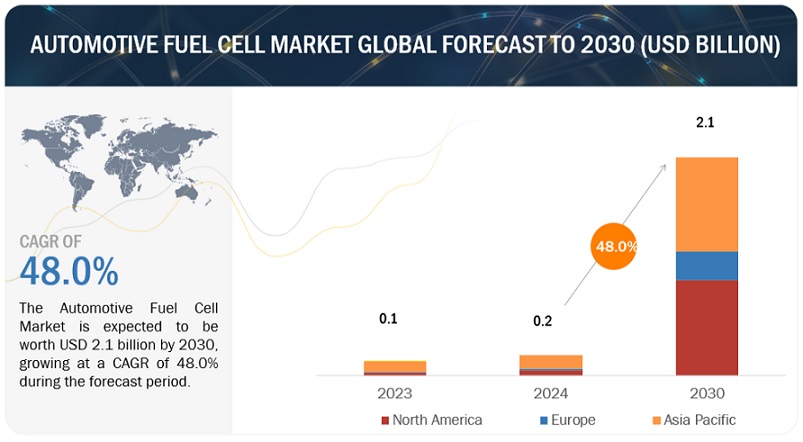According to a research report “Automotive Fuel Cell Market by Vehicle Type (Buses, Trucks, LCVs, Passenger Cars), Component, Fuel Type, Hydrogen Fuel Points, Operating Miles, Power, Capacity, Specialized Vehicle Type and Region – Global Forecast to 2030″ published by MarketsandMarkets, the global automotive fuel cell market is projected to grow from USD 0.2 billion in 2024 to USD 2.1 billion by 2030, at a CAGR of 48.0%.
Factors such as advancements in better fuel efficiency and increased driving range, rapid increase in investment and development for green hydrogen production, fast refueling, reduced oil dependency, and lower emissions compared to other vehicles are anticipated to contribute significantly to the revenue growth of the automotive fuel cell market. The evolution of fuel cell vehicles, combined with advancement in hydrogen technology, is poised to create favorable opportunities within this market.
Fuel Cell Hybrids with Battery Integration will form a promising product segment during forecast period
Fuel Cell Hybrid Electric Vehicles (FCHEVs) have emerged as a promising solution in the automotive fuel cell market, embodying a harmonious integration of fuel cell technology and secondary energy storage systems. Leading the way in this domain are upcoming models such as the Ford F-550 and H2X Warrego, showcasing the successful amalgamation of fuel cells and batteries in a single powertrain. These future models stand as pioneers, demonstrating the viability of FCHEVs, with automakers like Ford and H2X at the forefront. The popularity of FCHEVs is driven by their ability to address challenges faced by pure Fuel Cell Electric Vehicles (FCEVs). One of the key advantages of FCHEVs is their enhanced efficiency achieved by incorporating a secondary energy storage system, often taking the form of a battery. FCHEVs offer distinct advantages over their FCEV counterparts. Including a secondary battery facilitates smoother power delivery, reducing stress on the fuel cell and potentially extending its lifespan. Moreover, the presence of a battery enables energy recovery during braking, enhancing overall energy utilization. These factors make FCHEVs an appealing option for consumers looking for a cleaner and more efficient alternative to conventional vehicles. As technology advances and automakers refine their designs, FCHEVs are expected to play a crucial role in the transition toward sustainable and zero-emission transportation.
Download PDF Brochure @ https://www.marketsandmarkets.com/pdfdownloadNew.asp?id=14859789
Fuel Stack to act as growth catalysts in the Automotive Fuel Cell Market
The rapid growth of the automotive fuel stack market can be attributed to several factors, including stringent emissions regulations, government incentives, technological advancements, and diverse applications of fuel cell vehicles (FCVs). The fuel cell stack, a crucial fuel cell system component, consists of two flow field plates and a Membrane Electrode Assembly (MEA). It generates electricity in the form of direct current (DC), requiring a DC/AC converter for conversion into alternating current (AC) suitable for AC applications in Fuel Cell Electric Vehicles (FCEVs). An individual fuel cell produces less than 1.16 V of electricity in automotive applications. Multiple fuel cells are stacked together to enhance power generation, forming what is commonly known as a fuel cell stack. The fuel cell stack is considered the fuel cell system’s most expensive component due to platinum’s inclusion. The stack size determines the fuel cell’s power output, and increasing the number of fuel cell stacks can amplify power generation. Stacks are equipped with end plates and connections for integration into Fuel Cell (FC) modules. As the stack size increases, the cost per unit of power generated decreases, making fuel cells an efficient option for long-range transportation.
The industry adheres to the principle of economies of scale, whereby higher production volumes result in lower per-unit costs.Companies such as Ballard Power Systems and PowerCell AB have been actively engaged in the development of fuel cell stacks. For instance, in September 2020, Ballard Power Systems introduced the high-power density fuel cell stack, FCgen HPS, designed for vehicle propulsion, particularly in medium and heavy-duty vehicles. In July 2022, PowerCell announced a partnership with ZeroAvia, involving the delivery of 5000 units of 100 kW fuel cell stacks starting in 2024. ZeroAvia plans to utilize these fuel cell stacks to produce a 600 kW, low-temperature hydrogen-electric powertrain for a 19-seat commercial aircraft.
Key Players
The major players in Automotive Fuel Cell Market include Ballard Power Systems (Canada), Hyster-Yale (US), Plug Power (US), ITM Power(UK) and Cummins (US), among others. These companies have strong product portfolio as well as strong distribution networks at the global level.
Request Free Sample Report @ https://www.marketsandmarkets.com/requestsampleNew.asp?id=14859789
Media Contact
Company Name: MarketsandMarkets™ Research Private Ltd.
Contact Person: Mr. Aashish Mehra
Email: Send Email
Phone: 18886006441
Address:630 Dundee Road Suite 430
City: Northbrook
State: IL 60062
Country: United States
Website: https://www.marketsandmarkets.com/Market-Reports/automotive-fuel-cell-market-14859789.html
Press Release Distributed by ABNewswire.com
To view the original version on ABNewswire visit: Automotive Fuel Cell Market Size, Share, Trends & Forecast Report, 2030
